Microhabitat Conditions Influencing Ground Vegetation Dominants in an Ecotone between a Spruce (Picea abies (L.) H.Karst.) Forest and Clear-Cut Site during Ten Post-Logging Years
Abstract
:1. Introduction
2. Materials and Methods
2.1. Study Area
2.2. Data Collection
2.3. Data Analysis
3. Results
4. Discussion
5. Conclusions
Author Contributions
Funding
Data Availability Statement
Conflicts of Interest
References
- Marozas, V. Early succession of ground vegetation after clear-cuttings in spruce forests in a boreonemoral zone, Lithuania. Acta Biol. Univ. Daugavp. 2005, 5, 127–136. [Google Scholar]
- Kryshen, A.M. Plant Communities of Clear-Cut Areas in Karelia; Nauka: Moscow, Russia, 2006; p. 262. (In Russian) [Google Scholar]
- Genikova, N.; Mamontov, V. Decade-long dynamics of the ground vegetation in an ecotone between coniferous forest and clear-cut site. Environ. Sci. Proc. 2022, 22, 15. [Google Scholar] [CrossRef]
- Chen, J.; Franklin, J.F.; Spies, T.A. Growing-season microclimatic gradients from clearcut edges into old-growth Douglas-fir forests. Ecol. Appl. 1995, 5, 74–86. [Google Scholar] [CrossRef]
- Redding, T.E.; Hope, G.D.; Fortin, M.-J.; Schmidt, M.G.; Bailey, W.G. Spatial patterns of soil temperature and moisture across subalpine forest–clearcut edges in the southern interior of British Columbia. Can. J. Soil Sci. 2003, 83, 121–130. [Google Scholar] [CrossRef]
- Spittlehouse, D.L.; Adams, R.S.; Winkler, R.D. Forest, Edge, and Opening Microclimate at Sicamous Creek; Research Report 24; Ministry of Forests: Victoria, BC, Canada, 2004; 43p. [Google Scholar]
- Schmidt, M.; Jochheim, H.; Kersebaum, K.-C.; Lischeid, G.; Nendel, C. Gradients of microclimate, carbon and nitrogen in transition zones of fragmented landscapes—A review. Agric. For. Meteorol. 2017, 232, 659–671. [Google Scholar] [CrossRef]
- Genikova, N.V.; Mamontov, V.N.; Kryshen, A.M. Abundance of forest dwarf shrubs and microclimatic conditions in the bilberry spruce forest–clear-cut ecotone. Rastit. Resur. 2021, 2, 99–114. (In Russian) [Google Scholar] [CrossRef]
- Feklistov, P.A.; Sobolev, A.N.; Babich, N.A.; Sungurova, N.R.; Melekhov, V.I.; Bolotov, I.N. Edge effect in pine stands in the northern taiga. Russ. For. J. 2023, 2, 26–37. [Google Scholar] [CrossRef]
- Hansson, L. Bird Numbers across Edges between Mature Conifer Forest and Clearcuts in Central Sweden. Ornis Scand. 1983, 14, 97–103. Available online: https://www.jstor.org/stable/3676012 (accessed on 16 August 2023). [CrossRef]
- Kroodsma, R. Edge effect on breeding birds along power-line corridors in East Tennessee. Am. Midl. Nat. 1984, 118, 275–283. [Google Scholar] [CrossRef]
- Kollmann, J.; Buschor, M. Edges effects on seed predation by rodents in deciduous forests of northern Switzerland. Plant Ecol. 2002, 164, 249–261. [Google Scholar] [CrossRef]
- Kopij, G. Diversity and structure of avian communities in extensive lowland pine forests in relation to the distance from the forest edge. Biosyst. Divers. 2018, 26, 206–212. [Google Scholar] [CrossRef]
- Bergstedt, J.; Milber, P. The impact of logging intensity on field-layer vegetation in Swedish boreal forests. For. Ecol. Manag. 2001, 154, 105–115. [Google Scholar] [CrossRef]
- Marozas, V.; Grigaitis, V.; Brazaitis, G. Edge effect on ground vegetation in clear-cut edges of pine-dominated forests. Scand. J. For. Res. 2005, 20 (Suppl. 6), 43–48. [Google Scholar] [CrossRef]
- Genikova, N.V.; Mamontov, V.N.; Kryshen, A.M.; Kharitonov, V.A.; Moshnikov, S.A.; Toropova, E.V. Natural Regeneration of the Tree Stand in the Bilberry Spruce Forest—Clear-Cutting Ecotone Complex in the First Post-Logging Decade. Forests 2021, 12, 1542. [Google Scholar] [CrossRef]
- Genikova, N.V.; Kryshen, A.M. Dynamics of ground cover in Piceetum Myrtillosum in northern taiga during the first years after clear-cutting. Botanicheskii Zhurnal 2018, 103, 364–381. [Google Scholar] [CrossRef]
- MacArthur, R.H. Fluctuations of animal populations and a measure of community stability. Ecology 1955, 36, 533–536. [Google Scholar] [CrossRef]
- Chávez, V.; Macdonald, S.E. The influence of canopy patch mosaics on understory plant community composition in boreal mixedwood forest. For. Ecol. Manag. 2010, 259, 1067–1075. [Google Scholar] [CrossRef]
- Ellenberg, H. Zeigerwerte der Gefasspflanzen Mitteleuropas; Goltze: Gottingen, Germany, 1974. (In German) [Google Scholar]
- Eldegard, K.; Scholten, J.; Stokland, J.N.; Granhus, A.; Lie, M. The influence of stand density on bilberry (Vaccinium myrtillus L.) cover depends on stand age, solar irradiation, and tree species composition. For. Ecol. Manag. 2019, 432, 582–590. [Google Scholar] [CrossRef]
- Atlegrim, O.; Sjöberg, K. Response of bilberry (Vaccinium myrtillus) to clear-cutting and single-tree selection harvests in uneven-aged boreal Picea abies forests. For. Ecol. Manag. 1996, 86, 39–50. [Google Scholar] [CrossRef]
- Bergstedt, J.; Hagner, M.; Milberg, P. Effects on vegetation composition of a modified forest harvesting and propagation method compared with clear-cutting, scarification and planting. Appl. Veg. Sci. 2008, 11, 159–168. [Google Scholar] [CrossRef]
- Johnson, S.; Strengbom, J.; Kouki, J. Low levels of tree retention do not mitigate the effects of clearcutting on ground vegetation dynamics. For. Ecol. Manag. 2014, 330, 67–74. [Google Scholar] [CrossRef]
- Balandina, T.P.; Vakhrameeva, M.G. Vaccinium myrtillus. In Biologicheskaja Flora Moskovskoj Oblasti [Biological Flora of Moscow Region]; Publishing House of Moscow University: Moscow, Russia, 1980; Volume 6, pp. 132–145. [Google Scholar]
- Daubaras, R.; Česonienė, L.; Stakėnas, V.; Tamutis, V.; Zych, M. Impact of clear cuttings on biodiversity of boreal forests. Braz. J. For. Res. Colombo Embrapa Florestas 2019, 39, 487. [Google Scholar]
- Plantarium. Plants and Lichens of Russia and Neighboring Countries: Open Online Galleries and Plant Identification Guide. 2007–2022. Available online: https://www.plantarium.ru/lang/en.html (accessed on 22 September 2022).
- Česonienė, L.; Daubaras, R.; Bimbiraitė-Survilienė, K.; Kaškonienš, V.; Maruška, A.; Tiso, N.; Kaškonas, P.; Zych, M. Effects of clear-cuts in Scots Pine-dominated forests on Vaccinium myrtillus and Vaccinium vitis-idaea vegetative characteristics, and accumulation of phenolic compounds. Balt. For. 2018, 24, 278–286. [Google Scholar]
- Lebedeva, V.C.; Tikhodeeva, M.Y.; Ipatov, V.S. The effect of the tree layer on the soil cover in the bilberry aspen forest. Bot. Zhurnal 2008, 7, 996–1010. [Google Scholar]
- Hester, A.J.; Miles, J.; Gimingham, C.H. Succession from heather moorland to birch woodland. II. Growth and competition between Vaccinium myrtillus, Deschampsia flexuosa and Agrostis capillaris. J. Ecol. 1991, 79, 317–328. [Google Scholar] [CrossRef]
- Coll, L.; Balandier, P.; Picon-Cochard, C.; Prévosto, B.; Curt, T. Competition for water between beech seedlings and surrounding vegetation in different light and vegetation composition conditions. Ann. For. Sci. 2003, 60, 593–600. [Google Scholar] [CrossRef]
- Havas, P.; Kubin, E. Structure, growth and organic matter content in the vegetation cover of an old spruce forest in Northern Finland. Ann. Bot. Fennici 1983, 20, 115–149. [Google Scholar]
- Zubkova, E.V.; Frolov, P.V.; Bykhovets, S.S.; Nadporozhskaya, M.A.; Frolova, G.G. Bilberry and lingonberry cenopopulation mosaic structures and soil organic matter dynamics in southern Moscow region pine stands. Contemp. Probl. Ecol. 2022, 15, 908–918. [Google Scholar] [CrossRef]
- Melekhov, I.S.; Korkonosova, L.I.; Chertovskoy, V.G. Rukovodstvo po Izucheniju Tipov Koncentrirovannyh Vyrubok [A Guide to the Study of Types of Concentrated Clear-Cuts]; Nauka: Moscow, Russia, 1965; 180p. (In Russian) [Google Scholar]
- Ulanova, N.G.; Demidova, A.N. Population biology of Calamagrostis canescens (Web.) Roth in clearcuttings of spruce forests in south taiga. Byulleten MOIP 2001, 106, 51–58. (In Russian) [Google Scholar]
- Palvainen, M.; Finér, L.; Mannerkoski, H.; Piirainen, S.; Starr, M. Responses of ground vegetation species to clear-cutting in a boreal forest: Aboveground biomass and nutrient contents during the first 7 years. Ecol. Res. 2005, 20, 652–660. [Google Scholar] [CrossRef]
- Pykälä, J. Immediate increase in plant species richness after clear-cutting of boreal herb-rich forests. Appl. Veg. Sci. 2004, 7, 29–34. [Google Scholar] [CrossRef]
- Olsson, B.A.; Staaf, H. Influence of harvesting intensity of logging residues on ground vegetation in coniferous forests. J. Appl. Ecol. 1995, 32, 640–654. [Google Scholar] [CrossRef]
- Xiong, S.; Nilsson, C. The effects of plant litter on vegetation: A meta-analysis. J. Ecol. 1999, 87, 984–994. [Google Scholar] [CrossRef]
- Uotila, A.; Kouki, J. Understorey vegetation in spruce-dominated forests in eastern Finland and Russian Karelia: Successional patterns after anthropogenic and natural disturbances. For. Ecol. Manag. 2005, 215, 113–137. [Google Scholar] [CrossRef]
- Kravchenko, A.V. A Compendium of Karelian Flora (Vascular Plants); KarNC RAN: Petrozavodsk, Russia, 2007; 403p. (In Russian) [Google Scholar]
- Broderick, D.H. The biology of Canadian weeds. 93. Epilobium angustifolium L. (Onagraceae). Can. J. Plant Sci. 1990, 70, 247–259. [Google Scholar] [CrossRef]
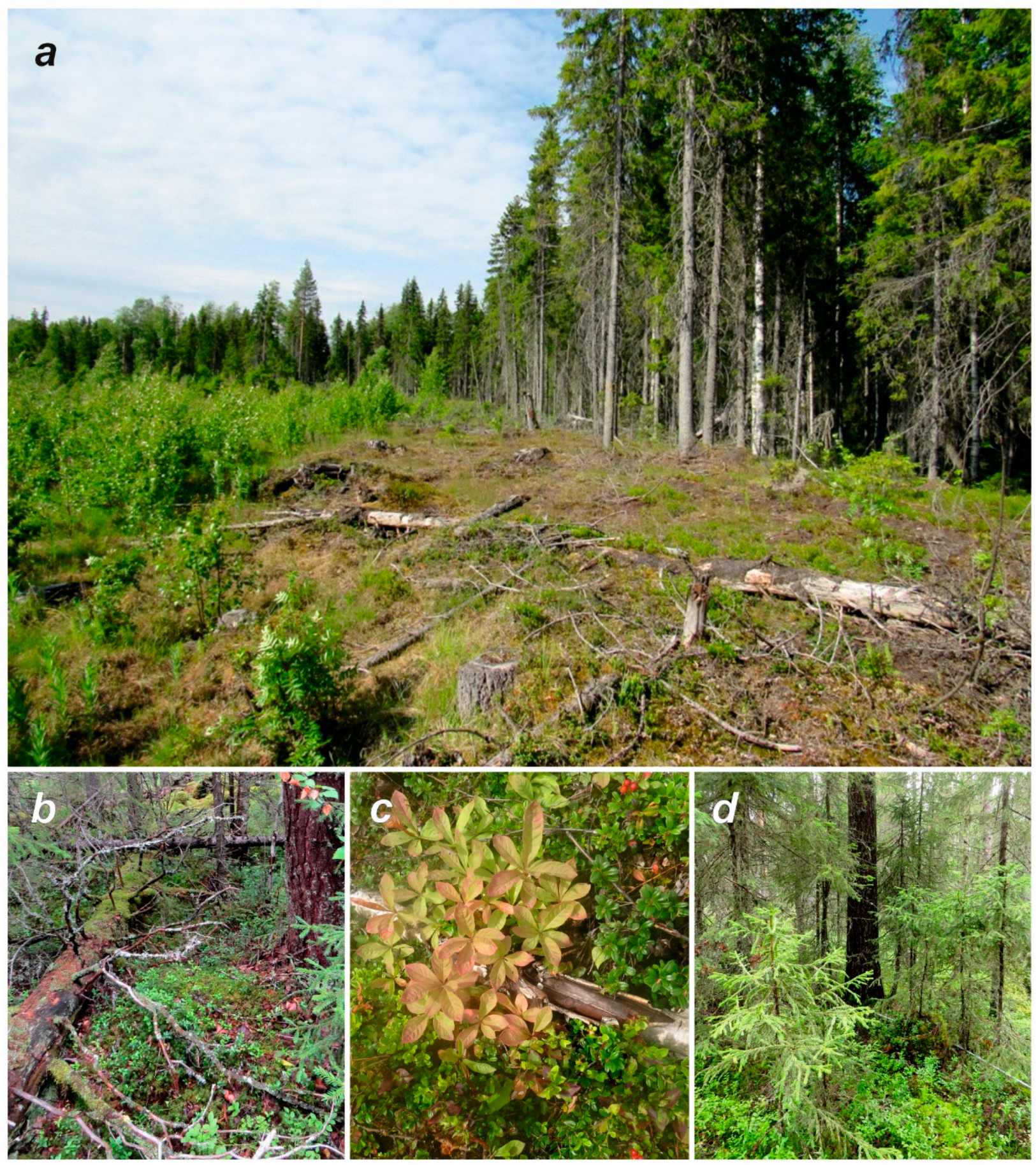
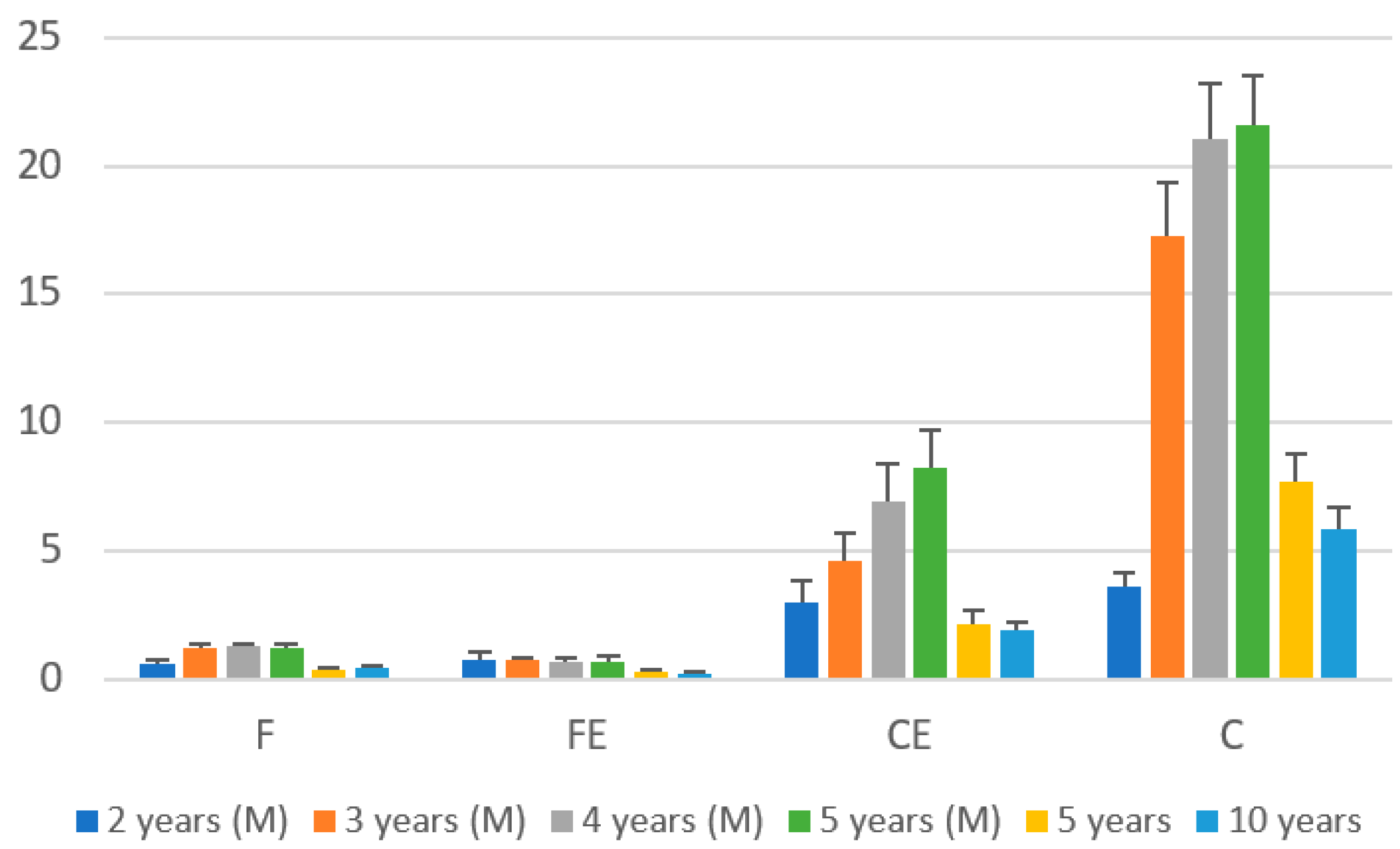
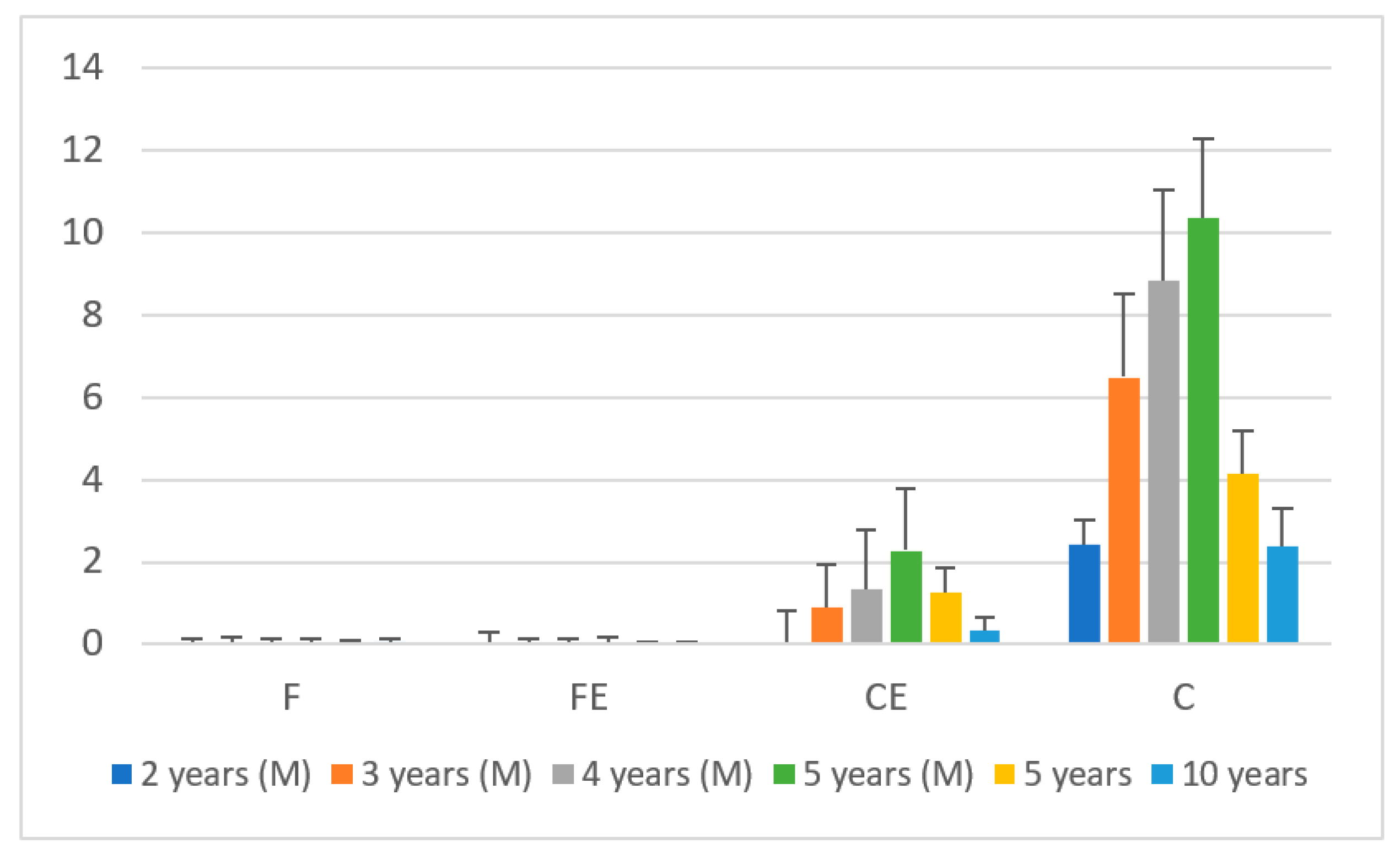
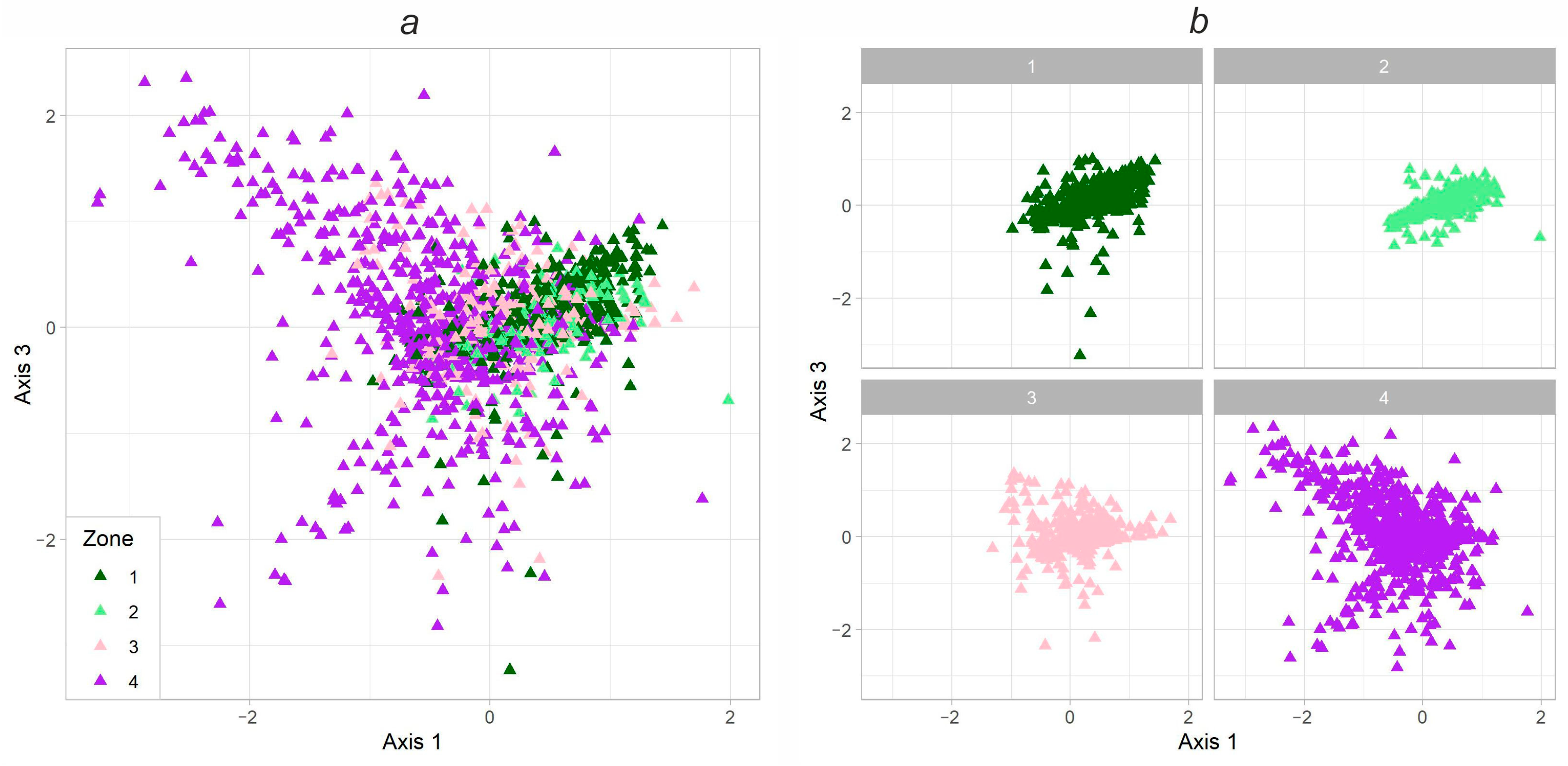
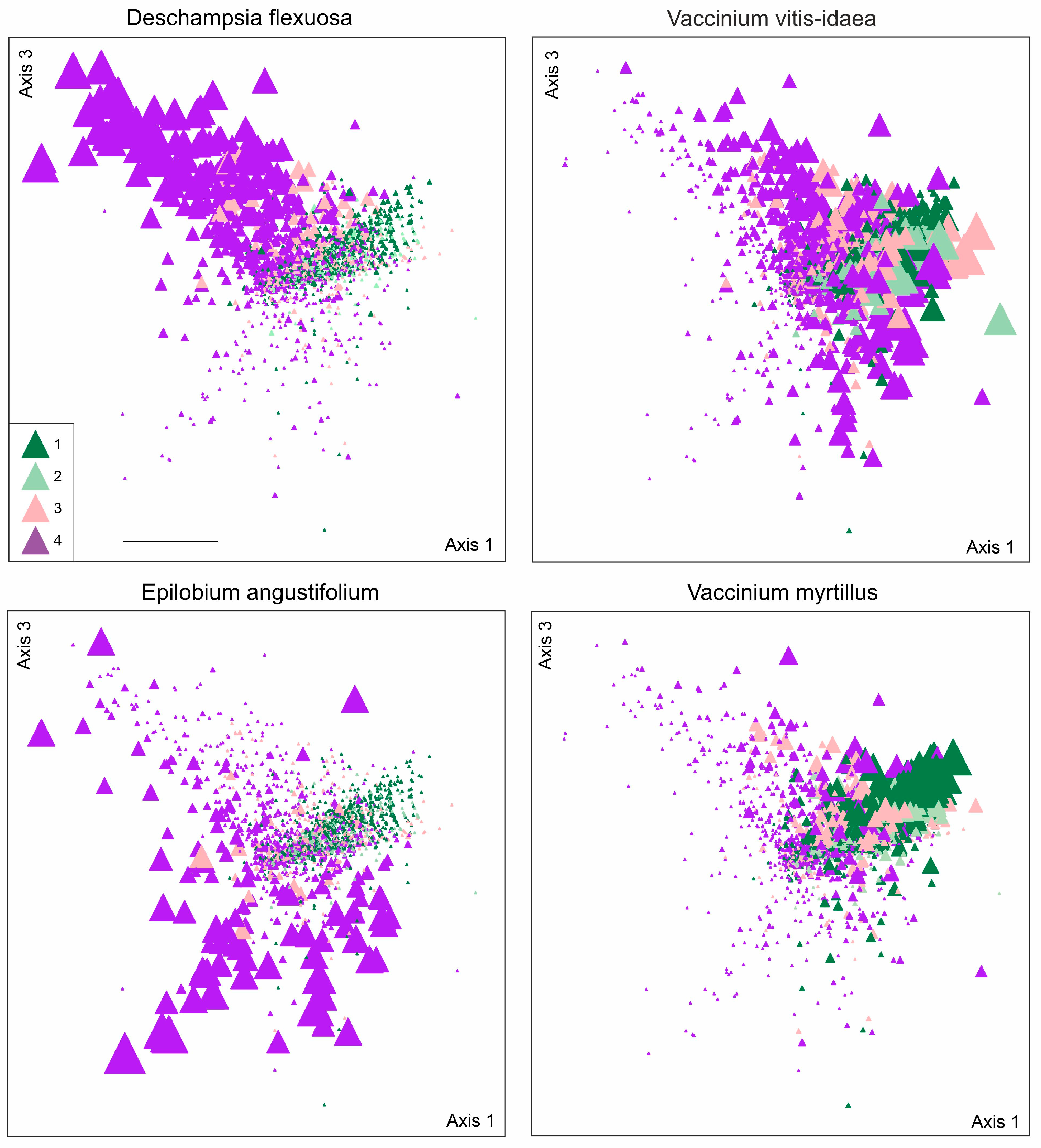
| EC Zone | Total Number of Vascular Plants | Mean Number of Vascular Plant Species Per Subplot | Pielou’s Index | Percentage Shares of Plant Groups in the Herb–Subshrub Layer | ||
|---|---|---|---|---|---|---|
| Subshrubs | Grasses | Forbs | ||||
| F | 10.7 ± 0.4 a | 4.9 ± 0.1 a | 0.48 ± 0.01 a | 88.2 ± 1.4 a | 1.6 ± 0.2 a | 10.2 ± 1.4 ab |
| FE | 7.4 ± 0.4 b | 3.8 ± 0.2 b | 0.49 ± 0.02 a | 91.7 ± 1.4 a | 1.4 ± 0.5 a | 6.9 ± 1.2 a |
| CE | 8.7 ± 0.4 c | 4.6 ± 0.2 a | 0.54 ± 0.02 b | 77.4 ± 2.6 b | 10.0 ± 1.8 b | 12.6 ± 1.8 b |
| C | 10.6 ± 0.5 a | 4.7 ± 0.2 a | 0.64 ± 0.02 c | 48.5 ± 3.1 c | 26.4 ± 2.8 c | 25.0 ± 2.8 c |
| Zone of the Ecotone Complex | ||||||||||||
|---|---|---|---|---|---|---|---|---|---|---|---|---|
| F—Forest | FE—Forest Edge | CE—Clear-Cutting Edge | C—Clear-Cut Site | |||||||||
| χ2 | df | p-Value | χ2 | df | p-Value | χ2 | df | p-Value | χ2 | df | p-Value | |
| Bilberry percentage cover | ||||||||||||
| time since logging | 5.14 | 4 | 0.27 | 8.74 | 4 | 0.07 | 33.24 | 4 | <0.001 | 15.86 | 4 | 0.003 |
| aspect | 50.98 | 3 | <0.001 | 29.03 | 3 | <0.001 | 46.18 | 3 | <0.001 | * 14.85 | 3 | 0.002 |
| microrelief | 12.45 | 3 | 0.006 | 9.97 | 3 | 0.02 | 4.41 | 3 | 0.224 | 3.64 | 3 | 0.30 |
| coniferous regeneration | 13.57 | 2 | 0.001 | 6.26 | 2 | 0.04 | 34.27 | 2 | <0.001 | 67.00 | 2 | <0.001 |
| deciduous regeneration | 17.26 | 2 | <0.001 | 0.92 | 2 | 0.63 | 1.93 | 2 | 0.384 | * 27.53 | 2 | <0.001 |
| overgrown downed deadwood | 3.769 | 2 | 0.15 | 14.25 | 2 | <0.001 | 0.16 | 2 | 0.924 | 4.07 | 2 | 0.13 |
| fresh downed deadwood | 13.42 | 2 | 0.001 | 37.71 | 2 | <0.001 | 3.97 | 2 | 0.14 | 1.54 | 2 | 0.46 |
| plant litter | 7.06 | 2 | 0.03 | 16.02 | 1 | <0.001 | * 34.20 | 2 | <0.001 | * 63.02 | 2 | <0.001 |
| PC of subshrubs | - | - | - | - | ||||||||
| PC of grasses | * 8.63 | 1 | 0.003 | * 11.63 | 1 | <0.001 | * 7.97 | 2 | 0.02 | 0.58 | 2 | 0.75 |
| PC of forbs | 0.64 | 2 | 0.72 | 11.02 | 2 | 0.004 | 31.67 | 2 | <0.001 | 3.55 | 2 | 0.17 |
| Cowberry percentage cover | ||||||||||||
| time since logging | 54.60 | 4 | <0.001 | 41.76 | 4 | <0.001 | 61.50 | 4 | <0.001 | 99.39 | 4 | <0.001 |
| aspect | 11.04 | 3 | 0.01 | 28.27 | 3 | <0.001 | 32.66 | 3 | <0.001 | 204.00 | 3 | <0.001 |
| microrelief | 20.21 | 3 | <0.001 | 2.45 | 3 | 0.48 | 16.13 | 3 | 0.001 | 44.58 | 3 | <0.001 |
| coniferous regeneration | 3.37 | 2 | 0.18 | 1.03 | 2 | 0.59 | 0.39 | 2 | 0.82 | 13.99 | 2 | <0.001 |
| deciduous regeneration | 2.28 | 2 | 0.3185 | 0.09 | 2 | 0.95 | 0.90 | 2 | 0.64 | 2.34 | 2 | 0.31 |
| overgrown downed deadwood | 0.89 | 2 | 0.64 | 0.22 | 2 | 0.89 | 0.16 | 2 | 0.92 | 0.76 | 2 | 0.68 |
| fresh downed deadwood | 12.75 | 2 | 0.002 | 2.78 | 2 | 0.25 | 5.81 | 2 | 0.054 | 8.08 | 2 | 0.02 |
| plant litter | 6.88 | 2 | 0.03 | 0.15 | 1 | 0.69 | 29.48 | 2 | <0.001 | 135.35 | 2 | <0.001 |
| PC of subshrubs | - | - | - | - | ||||||||
| PC of grasses | 2.59 | 1 | 0.11 | 0.71 | 1 | 0.39 | 21.06 | 2 | <0.001 | 26.94 | 2 | <0.001 |
| PC of forbs | 18.54 | 2 | <0.001 | 19.62 | 2 | <0.001 | 8.09 | 2 | 0.02 | 1.72 | 2 | 0.42 |
| Wavy hair-grass percentage cover | ||||||||||||
| time since logging | * 72.27 | 4 | <0.001 | * 33.58 | 4 | <0.001 | 36.73 | 4 | <0.001 | 144.04 | 4 | <0.001 |
| aspect | * 54.70 | 3 | <0.001 | * 76.29 | 3 | <0.001 | 5.33 | 3 | 0.15 | 119.77 | 3 | <0.001 |
| microrelief | 5.28 | 3 | 0.15 | 2.31 | 3 | 0.51 | 3.66 | 3 | 0.30 | 6.58 | 3 | 0.09 |
| coniferous regeneration | 2.64 | 2 | 0.26 | * 6.39 | 2 | 0.04 | 18.63 | 2 | <0.001 | 4.51 | 2 | 0.10 |
| deciduous regeneration | 2.02 | 2 | 0.36 | 2.42 | 2 | 0.29 | 0.52 | 2 | 0.77 | 3.19 | 2 | 0.20 |
| overgrown downed deadwood | 1.09 | 2 | 0.57 | * 8.33 | 2 | 0.02 | 4.73 | 2 | 0.09 | 2.91 | 2 | 0.23 |
| fresh downed deadwood | * 27.59 | 2 | <0.001 | * 30.65 | 2 | <0.001 | 13.35 | 2 | 0.001 | 12.15 | 2 | 0.002 |
| plant litter | * 34.13 | 2 | <0.001 | * 35.47 | 1 | <0.001 | 6.85 | 2 | 0.03 | 84.57 | 2 | <0.001 |
| PC of subshrubs | 4.66 | 2 | 0.09 | 0.67 | 2 | 0.71 | * 22.81 | 2 | <0.001 | 44.30 | 2 | <0.001 |
| PC of grasses | - | - | - | - | ||||||||
| PC of forbs | 0.32 | 2 | 0.85 | * 13.00 | 2 | 0.002 | 14.53 | 2 | <0.001 | 3.28 | 2 | 0.19 |
| Fireweed percentage cover | ||||||||||||
| time since logging | * 11.72 | 4 | 0.02 | ** | * 31.67 | 4 | <0.001 | 109.21 | 4 | <0.001 | ||
| aspect | 5.90 | 3 | 0.11 | * 8.76 | 3 | 0.03 | 60.75 | 3 | <0.001 | |||
| microrelief | 6.39 | 3 | 0.09 | 4.83 | 3 | 0.18 | 22.51 | 3 | <0.001 | |||
| coniferous regeneration | 0.60 | 2 | 0.74 | 6.0 | 2 | 0.05 | 20.86 | 2 | <0.001 | |||
| deciduous regeneration | 0.16 | 2 | 0.92 | 0.79 | 2 | 0.67 | 1.81 | 2 | 0.40 | |||
| overgrown downed deadwood | 0.25 | 2 | 0.87 | 0.61 | 2 | 0.74 | * 11.99 | 2 | 0.002 | |||
| fresh downed deadwood | 0.17 | 2 | 0.91 | 7.20 | 2 | 0.03 | 4.63 | 2 | 0.09 | |||
| plant litter | 1.06 | 2 | 0.58 | 5.46 | 2 | 0.06 | * 11.61 | 2 | 0.003 | |||
| PC of subshrubs | 0.30 | 2 | 0.85 | 3.84 | 2 | 0.14 | 10.62 | 2 | 0.005 | |||
| PC of grasses | 1.49 | 1 | 0.22 | * 15.62 | 2 | <0.001 | * 20.12 | 2 | <0.001 | |||
| PC of forbs | - | - | - | |||||||||
| Average height of bilberry shoots | ||||||||||||
| time since logging | 22.72 | 3 | <0.001 | 36.61 | 3 | <0.001 | 8.72 | 3 | 0.03 | 33.71 | 3 | <0.001 |
| aspect | 67.97 | 3 | <0.001 | 32.39 | 3 | <0.001 | 80.97 | 3 | <0.001 | 2.92 | 3 | 0.40 |
| microrelief | 3.89 | 3 | 0.27 | 7.49 | 3 | 0.06 | 1.69 | 3 | 0.64 | 8.16 | 3 | 0.04 |
| coniferous regeneration | 0.12 | 2 | 0.94 | 0.21 | 2 | 0.89 | 27.63 | 2 | <0.001 | 11.11 | 2 | 0.004 |
| deciduous regeneration | 15.16 | 2 | <0.001 | 5.67 | 2 | 0.06 | 11.64 | 2 | 0.003 | 26.59 | 2 | <0.001 |
| overgrown downed deadwood | 5.43 | 2 | 0.06 | 1.85 | 2 | 0.39 | 5.83 | 2 | 0.05 | 1.17 | 2 | 0.55 |
| fresh downed deadwood | 1.13 | 2 | 0.56 | 7.87 | 2 | 0.02 | 3.31 | 2 | 0.19 | 1.74 | 2 | 0.42 |
| plant litter | 14.07 | 2 | <0.001 | 1.55 | 1 | 0.46 | 4.66 | 2 | 0.09 | 2.70 | 2 | 0.26 |
| PC of subshrubs | 98.32 | 1 | <0.001 | 29.89 | 1 | <0.001 | 9.64 | 2 | 0.002 | 41.78 | 2 | <0.001 |
| PC of grasses | 3.31 | 1 | 0.07 | 5.09 | 1 | 0.02 | 10.44 | 2 | 0.005 | 32.09 | 2 | <0.001 |
| PC of forbs | 13.23 | 2 | 0.001 | 2.20 | 2 | 0.33 | 20.64 | 2 | <0.001 | 2.28 | 2 | 0.32 |
| Average height of cowberry shoots | ||||||||||||
| time since logging | 146.56 | 3 | <0.001 | 99.46 | 3 | <0.001 | 33.69 | 3 | <0.001 | 140.26 | 3 | <0.001 |
| aspect | 110.20 | 3 | <0.001 | 37.28 | 3 | <0.001 | 91.90 | 3 | <0.001 | 18.71 | 3 | <0.001 |
| microrelief | 1.01 | 3 | 0.79 | 9.57 | 3 | 0.02 | 1.45 | 3 | 0.69 | 13.67 | 3 | 0.003 |
| coniferous regeneration | 1.59 | 2 | 0.45 | 6.62 | 2 | 0.04 | 23.99 | 2 | <0.001 | 28.78 | 2 | <0.001 |
| deciduous regeneration | 8.10 | 2 | 0.02 | 2.81 | 2 | 0.24 | 11.68 | 2 | 0.003 | 34.59 | 2 | <0.001 |
| overgrown downed deadwood | 1.60 | 2 | 0.45 | 5.11 | 2 | 0.08 | 1.55 | 2 | 0.46 | 1.24 | 2 | 0.54 |
| fresh downed deadwood | 20.06 | 2 | <0.001 | 1.32 | 2 | 0.52 | 1.31 | 2 | 0.52 | 8.66 | 2 | 0.01 |
| plant litter | 51.12 | 2 | <0.001 | 0.50 | 1 | 0.78 | 9.36 | 2 | 0.009 | 6.48 | 2 | 0.04 |
| PC of subshrubs | 31.31 | 1 | <0.001 | 24.71 | 1 | <0.001 | 28.64 | 2 | <0.001 | 79.72 | 2 | <0.001 |
| PC of grasses | 0.01 | 1 | 0.93 | 5.55 | 1 | 0.02 | 3.87 | 2 | 0.14 | 7.06 | 2 | 0.03 |
| PC of forbs | 5.52 | 2 | 0.06 | 8.77 | 2 | 0.01 | 14.28 | 2 | <0.001 | 30.63 | 2 | <0.001 |
| EC Zone | Time Since Clear-Cutting | |||||
|---|---|---|---|---|---|---|
| 2 Years (M) | 3 Years (M) | 4 Years (M) | 5 Years (M) | 5 Years | 10 Years | |
| Percentage cover of bilberry: | ||||||
| F | 19.3 ± 1.0 a (100%) | 20.1 ± 1.6 a (100%) | 19.2 ± 1.4 a (100%) | 23.3 ± 1.4 a (100%) | 21.7 ± 1.3 a (100%) | 22.4 ± 1.4 a (100%) |
| FE | 12.0 ± 1.2 b (62%) | 12.7 ± 1.7 b (63%) | 11.7 ± 1.4 b (61%) | 17.1 ± 1.6 b (73%) | 9.5 ± 1.3 b (44%) | 16.6 ± 1.7 b (74%) |
| CE | 6.3 ± 0.8 c (33%) | 7.2 ± 1.2 c (36%) | 6.7 ± 1.0 c (35%) | 8.3 ± 1.0 c (36%) | 8.2 ± 1.1 b (38%) | 14.1 ± 1.4 b (63%) |
| C | 2.6 ± 0.4 d (13%) | 3.6 ± 0.6 c (18%) | 4.2 ± 0.7 c (22%) | 5.1 ± 0.6 c (22%) | 3.1 ± 0.4 c (14%) | 6.8 ± 0.8 c (30%) |
| Height of bilberry shoots: | ||||||
| F | – * | 17.8 ± 0.4 a (100%) | 15.6 ± 0.4 a (100%) | 14.8 ± 0.3 a (100%) | 16.7 ± 0.3 a (100%) | 17.1 ± 0.4 a (100%) |
| FE | – | 15.4 ± 0.6 b (86%) | 14.0 ± 0.4 b (76%) | 12.1 ± 0.5 b (82%) | 12.5 ± 0.3 b (75%) | 14.1 ± 0.4 b (82%) |
| CE | – | 11.9 ± 0.6 c (67%) | 10.4 ± 0.5 c (67%) | 10.0 ± 0.4 c (68%) | 12.7 ± 0.5 b (76%) | 12.4 ± 0.4 c (75%) |
| C | – | 8.8 ± 0.4 d (49%) | 9.2 ± 0.3 c (59%) | 8.7 ± 0.2 d (59%) | 9.6 ± 0.3 c (57%) | 11.7 ± 0.5 c (68%) |
| EC Zone | Time Since Clear-Cutting | |||||
|---|---|---|---|---|---|---|
| 2 Years (M) | 3 Years (M) | 4 Years (M) | 5 Years (M) | 5 Years | 10 Years | |
| Percentage cover of cowberry: | ||||||
| F | 14.1 ± 0.7 a (100%) | 19.7 ± 1.3 a (100%) | 25.1 ± 1.3 a (100%) | 27.4 ± 1.4 a (100%) | 13.4 ± 0.8 a (100%) | 21.4 ± 1.1 a (100%) |
| FE | 17.3 ± 1.1 b (123%) | 24.8 ± 2.1 b (126%) | 32.4 ± 1.9 b (129%) | 31.7 ± 2.0 ab (116%) | 16.5 ± 1.1 b (123%) | 24.7 ± 1.9 a (115%) |
| CE | 16.0 ± 1.3 ab (113%) | 29.6 ± 2.6 b (150%) | 35.8 ± 2.4 b (143%) | 34.2 ± 2.6 b (125%) | 14.1 ± 1.3 ab (105%) | 14.3 ± 1.3 b (67%) |
| C | 8.0 ± 0.7 c (57%) | 15.2 ± 1.2 c (77%) | 24.3 ± 1.5 a (97%) | 26.5 ± 1.5 a (97%) | 10.9 ± 0.6 c (81%) | 12.9 ± 1.0 b (60%) |
| Height of cowberry shoots: | ||||||
| F | – * | 14.9 ± 0.3 a (100%) | 13.3 ± 0.3 a (100%) | 12.3 ± 0.3 a (100%) | 12.1 ± 0.2 a (100%) | 16.1 ± 0.3 a (100%) |
| FE | – | 14.1 ± 0.4 a (95%) | 12.2 ± 0.4 b (92%) | 10.5 ± 0.4 b (85%) | 9.6 ± 0.2 b (79%) | 13.2 ± 0.4 b (82%) |
| CE | – | 11.1 ± 0.6 b (74%) | 9.6 ± 0.4 c (72%) | 8.5 ± 0.3 c (69%) | 8.7 ± 0.3 c (72%) | 10.6 ± 0.4 c (66%) |
| C | – | 8.2 ± 0.3 c (55%) | 8.8 ± 0.2 c (66%) | 8.4 ± 0.3 c (68%) | 6.7 ± 0.1 d (55%) | 11.0 ± 0.3 c (68%) |
Disclaimer/Publisher’s Note: The statements, opinions and data contained in all publications are solely those of the individual author(s) and contributor(s) and not of MDPI and/or the editor(s). MDPI and/or the editor(s) disclaim responsibility for any injury to people or property resulting from any ideas, methods, instructions or products referred to in the content. |
© 2023 by the authors. Licensee MDPI, Basel, Switzerland. This article is an open access article distributed under the terms and conditions of the Creative Commons Attribution (CC BY) license (https://creativecommons.org/licenses/by/4.0/).
Share and Cite
Genikova, N.; Mamontov, V. Microhabitat Conditions Influencing Ground Vegetation Dominants in an Ecotone between a Spruce (Picea abies (L.) H.Karst.) Forest and Clear-Cut Site during Ten Post-Logging Years. Forests 2023, 14, 2125. https://doi.org/10.3390/f14112125
Genikova N, Mamontov V. Microhabitat Conditions Influencing Ground Vegetation Dominants in an Ecotone between a Spruce (Picea abies (L.) H.Karst.) Forest and Clear-Cut Site during Ten Post-Logging Years. Forests. 2023; 14(11):2125. https://doi.org/10.3390/f14112125
Chicago/Turabian StyleGenikova, Nadezhda, and Viktor Mamontov. 2023. "Microhabitat Conditions Influencing Ground Vegetation Dominants in an Ecotone between a Spruce (Picea abies (L.) H.Karst.) Forest and Clear-Cut Site during Ten Post-Logging Years" Forests 14, no. 11: 2125. https://doi.org/10.3390/f14112125
APA StyleGenikova, N., & Mamontov, V. (2023). Microhabitat Conditions Influencing Ground Vegetation Dominants in an Ecotone between a Spruce (Picea abies (L.) H.Karst.) Forest and Clear-Cut Site during Ten Post-Logging Years. Forests, 14(11), 2125. https://doi.org/10.3390/f14112125






